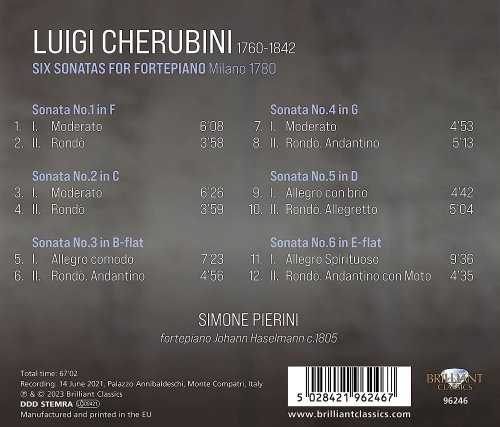
Simone El Oufir Pierini - Cherubini: Six Sonatas for Fortepiano (2023)
BAND/ARTIST: Simone El Oufir Pierini
- Title: Cherubini: Six Sonatas for Fortepiano
- Year Of Release: 2023
- Label: Brilliant Classics
- Genre: Classical
- Quality: FLAC (tracks)
- Total Time: 67:01 min
- Total Size: 297 MB
- WebSite: Album Preview

Tracklist:
01. Sonata No. 1 in F Major: I. Moderato
02. Sonata No. 1 in F Major: II. Rondò
03. Sonata No. 2 in C Major: I. Moderato
04. Sonata No. 2 in C Major: II. Rondò
05. Sonata No. 3 in B-Flat Major: I. Allegro Comodo
06. Sonata No. 3 in B-Flat Major: II. Rondò. Andantino
07. Sonata No. 4 in G Major: I. Moderato
08. Sonata No. 4 in G Major: II. Rondò. Andantino
09. Sonata No. 5 in D Major: I. Allegro con Brio
10. Sonata No. 5 in D Major: II. Rondò. Allegretto
11. Sonata No. 6 in E-Flat Major: I. Allegro Spirituoso
12. Sonata No. 6 in E-Flat Major: II. Rondò. Andantino con Moto
In the second half of 18th century, keyboard music in Tuscany was flourishing. Many composers wrote music for both the fortepiano and the harpsichord: the former, which was invented just before the turn of the 18th century in Florence by harpsichord maker Bartolomeo Cristofori (1655–1731), rose to an incredible degree of popularity in the last decades of the century at the expense of the latter, which experienced the last moments of its glorious history. At any rate, it was by no means uncommon that composers published music intended to be played on either instrument, as almost all keyboard pieces written in Tuscany during the 1780s were explicitly addressed per il clavicembalo o fortepiano (for the harpsichord or piano).
The Florence-born composer Luigi Cherubini (1760–1842) published his Sei Sonate per il Cimbalo around 1780; they are currently believed to be the first published work by the composer, although he had written operas and religious music prior to the publication of this work. Cherubini had moved to Bologna then Milan around that same year to study with Giuseppe Sarti (1729–1802). His chef d’oeuvre is generally recognized to be the Requiem in C minor, composed for the commemoration of the 24th anniversary of Louis XVI’s death. His compositional efforts in opera include tragedies lyriques (Démophon, Les Abencerages, Ali Baba) and opéra-comiques (Lodoïska, Medée, Faniska, Bayard à Mézières), as well as other operatic forms. In 1821, he was appointed director of the Paris Conservatory, after a highly acclaimed career as a composition teacher.
Although this was the only solo keyboard work written by Cherubini, the sheer brilliance of these sonatas allows them to be considered a pinnacle in this genre, proving the early maturity of their composer. The style of these sonatas is not too far from the musical fashion of the time: they all consist of two movements, the first in sonata-form, the second a rondò where the second theme is typically characterised by highly virtuosic writing. All six sonatas follow this strict formal code, however, Cherubini manages to create a surprising variety in the themes and their development. Each sonata could, in fact, depict a different stock character from the commedia dell’Arte, with their strict formal codification employed in a theatrical way thanks to the perfect balance of ideas set out each time. Even the bass seems to be adjusted depending on the mood of the theme – Cherubini employs Murky bass, Alberti bass and even counterpoint. The harmonic closeness between the key signatures of each sonata gives further cohesion to the whole set.
The Florence-born composer Luigi Cherubini (1760–1842) published his Sei Sonate per il Cimbalo around 1780; they are currently believed to be the first published work by the composer, although he had written operas and religious music prior to the publication of this work. Cherubini had moved to Bologna then Milan around that same year to study with Giuseppe Sarti (1729–1802). His chef d’oeuvre is generally recognized to be the Requiem in C minor, composed for the commemoration of the 24th anniversary of Louis XVI’s death. His compositional efforts in opera include tragedies lyriques (Démophon, Les Abencerages, Ali Baba) and opéra-comiques (Lodoïska, Medée, Faniska, Bayard à Mézières), as well as other operatic forms. In 1821, he was appointed director of the Paris Conservatory, after a highly acclaimed career as a composition teacher.
Although this was the only solo keyboard work written by Cherubini, the sheer brilliance of these sonatas allows them to be considered a pinnacle in this genre, proving the early maturity of their composer. The style of these sonatas is not too far from the musical fashion of the time: they all consist of two movements, the first in sonata-form, the second a rondò where the second theme is typically characterised by highly virtuosic writing. All six sonatas follow this strict formal code, however, Cherubini manages to create a surprising variety in the themes and their development. Each sonata could, in fact, depict a different stock character from the commedia dell’Arte, with their strict formal codification employed in a theatrical way thanks to the perfect balance of ideas set out each time. Even the bass seems to be adjusted depending on the mood of the theme – Cherubini employs Murky bass, Alberti bass and even counterpoint. The harmonic closeness between the key signatures of each sonata gives further cohesion to the whole set.
Year 2023 | Classical | FLAC / APE
As a ISRA.CLOUD's PREMIUM member you will have the following benefits:
- Unlimited high speed downloads
- Download directly without waiting time
- Unlimited parallel downloads
- Support for download accelerators
- No advertising
- Resume broken downloads


